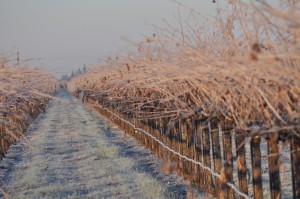 Below average cold, below average rainfall, increasing costs, more regulations and tougher competition. We seem to be experiencing our own modern day Iliad. But it could always be worse and baseball opening day is only 55 days away.
Below average cold, below average rainfall, increasing costs, more regulations and tougher competition. We seem to be experiencing our own modern day Iliad. But it could always be worse and baseball opening day is only 55 days away.
Dry conditions have taken front page attention to the recent cold weather. With weather forecasts predicting only slight rainfall if any for the rest of the winter, growers are beginning to ask questions about how these extreme weather conditions might affect their vines. With that in mind, I have put down some thoughts from local experience and after talking with UC Davis Viticulture and Enology Deportment professor Dr. Andy Walker. The points that follow are my view as a UCCE Farm Advisor. As such, batteries are not included and may require some assembly.
Drought, Cold, and the Affects on Vines
- Mid-winter irrigation is a good idea now, if not already.
- Irrigation in and of itself won’t start growth. Average temperatures need to be above 50°F on an ongoing basis. And soil temperatures are slower to respond to warming, especially after this cold winter. Temperature trumps water availability with regard to vine growth.
- Usually budbreak for Chardonnay occurs at about 300 Growing Degree Days (GDD) in Lodi, which is March 15th over the long term. This year we currently have 100 GDD as of January 24th, 2014. We seem to be gaining about 4 GDD per day as the daily maximums are 10 to 12 degrees F ABOVE normal, but minimums are 8 to 10 degrees BELOW average.
- The bigger problem is that roots are still active, although at a very low rate. Dry soils create dry roots that can result in erratic budbreak, delayed push (or maybe advanced), odd shoot growth similar to B deficiency (this is Barnes’s Syndrome of drought induced B deficiency). This induced B deficiency is real and can also affect fruit set. For more information on drought-induced B deficiency, see the UC Integrated Viticulture boron webpage.
- Other nutrients can also be affected. We may see potassium-deficiency-like symptoms during the season and even nitrogen uptake and utilization may be affected.
The Advice
- Irrigate for at least 24 to 36 hours, depending on soil texture and depth. Split applications over a few days may help. Then wait for the next rain.
- If only a week or 10 days have passed before a rain approaches, irrigate again but only “half irrigation” (12 to 24 hrs) maybe.
- If several weeks have passed and rain is coming, irrigate right before the rain with another 24 to 36 hrs plus.
- If no rain in 21 to 30 days, irrigate “fully” (24 to 36 hrs) again. Irrigation should be more accurately considered in acre inches so the number of hours depends on vine spacing, but for consideration here hours should do.
- Until budbreak, irrigate every 3 to 4 weeks if no rain shows up.
- Irrigate on a reduced ET schedule on the low side of about 50 to 60% for reds and the high side for whites.
- If applying residual herbicide now, irrigate berm immediately after to help “set” the herbicide.
- During any hot spells later on, apply as much water as possible (100%ET), as vines make progress towards harvest.
- All of the above depends on soil texture and depth, and cover crop presence or absence. And grower and winery goals.
- Add 15 to 20% for cover crop or non-cultivation (resident vegetation) sites.
- The other odd thing about this winter of 2014 is that this is the one year everyone probably should have pruned their Eutypa sensitive varieties a month ago! But at this point pruning late may help delay budbreak slightly. Or prune to long spurs now and make the final cuts as vines begin to push.
Good Luck in 2014!

![IMG_1871[1]](https://www.lodigrowers.com/wp-content/uploads/2014/01/IMG_18711-300x225.jpg)

